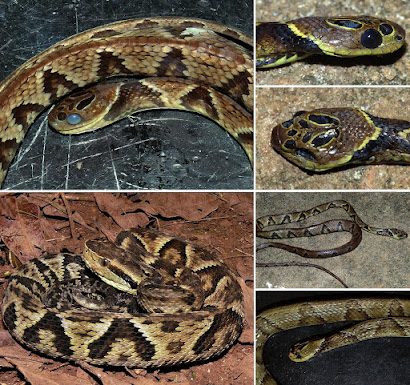 |
| Dipsas bothropoides Mebert, Passos, Fernandes, Entiauspe-Neto, Alvez, Machado & Lopes, 2020 |
Abstract
We describe a new species of snail-eating snake from two localities within the Atlantic Forest of the states of Bahia and Minas Gerais, Brazil. The new species differs remarkably from all congeners by its dorsal pattern consisting of sharply bordered triangles resembling the pattern of sympatric pitvipers, more precisely Bothrops jararaca and B. pirajai. Parameters of external morphology of the new species resemble those of the Dipsas incerta species group. Its scalation, body/head shape, and color pattern are most similar to D. alternans, a species known to occur 360 km farther south, across the Rio Doce river. The new species differs from D. alternans by exhibiting triangular dorsal blotches and a higher number of pileus blotches, by the distribution of ventral spots and morphology of the supratemporal and premaxillae, as well as in hemipenial morphology. We also provide comparisons of the new species with all sympatric and/or parapatric congeners. The finding of a new snake species in the Atlantic rainforest of southern Bahia and adjacent Minas Gerais is particularly surprising as this region is easily accessible and represents a well-sampled area regarding herpetological surveys in the last decades.
KEYWORDS: color pattern, Dipsas alternans, Dipsas incerta species group, Hemipenial and skull morphology, Pitviper aposematism
 |
| Figure 6. Dorsal and lateral views of the skull of (A) Dipsas bothropoides sp. nov., (B) D. alternans, and (C) D. sazimai. Arrows indicate diagnostic features of the new taxon. Scale bars = 1 mm.. |
Dipsas bothropoides sp. nov.
Terra typica: Montane Atlantic rainforest in the Serra do Cariri that occurs along the border between the states of Minas Gerais and Bahia and separates the basins of the Jequitinhonha and Buranhém rivers. The type was found within Fazenda Duas Barras, which includes patches of unprotected Atlantic rainforest and well-preserved secondary forests, as well as open pastures associated with cattle breeding (see also Cruz et al., 2007).
General diagnosis and variation:
The new species is allocated to the genus Dipsas by possessing the following derived characters combined from Peters (1960), Cadle (2007), and Arteaga et al. (2018): mental sulcus (groove) absent, shape of chinshields (square or polygonal rather than elongate and narrow), more than two pairs of chinshields, absence of supralabial noticeably higher than other supralabials and in contact with postocular, and Harderian gland occupying the entire postorbital region.
Dipsas bothropoides sp. nov. (holotype and paratype) is distinguished from all currently recognized congeners by the unique combination of the following morphological characters: (1) dorsal scale rows 15/15/15, smooth; (2) one pair of infralabials in contact posterior to mental; (3) infralabials 8–9, 4–6th or only 4th in contact with second pair of chinshields; gulars separating infralabials from preventrals and ventrals; (4) supralabials 8–9 (4–5th or 5–6th contacting orbit); (5) nasal partially or fully divided; (6) internasal paired or fused; (7) loreal square usually in contact with orbit, but contact can be obstructed by a tiny interjacent scale; (8) preoculars 1 or 2 present above and/or below loreal, excluding prefrontal from orbit; (9) postoculars two, excluding temporals from orbit;
....
Etymology: The specific epithet represents the Latinized form of “bothros” derived from the Greek (ßóθρς), referring to the facial pit, and also referring to the genus Bothrops, the species-rich terrestrial Neotropical pitvipers. The suffix -oides means ‘similar to' or ‘having the nature of,’ in reference to the great similarity of the dorsal color pattern with many members of the genus Bothrops, especially the sympatric B. jararaca and B. pirajai.
Konrad Mebert, Paulo Passos, Daniel S. Fernandes, Omar Machado Entiauspe-Neto, Fatima Queiroz Alvez, Alessandra S. Machado and Ricardo T. Lopes. 2020. A New Species of Snail-Eating Snake, Dipsas Cope, 1860 (Serpentes: Colubridae: Dipsadinae), from the Atlantic Forest of Brazil. South American J. of Herpetology. 17(3); 43-62. DOI: 10.2994/SAJH-D-17-00112.1








